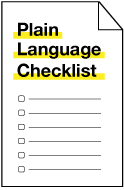Text written for the general public should use plain language, which is defined as writing that can be understood the first time it’s read or heard.
Plain language is not “dumbed down” writing—it’s a way of writing that makes text easier for all readers to understand. And it’s more necessary than you might think: research by the Mayor’s Office of Operations found that many users became confused when text was written above a fifth-grade level. And even expert readers report having an easier time understanding text written in plain language.
Best Practices
Here are some tips for creating plain, readable content:
- Write text at an eighth-grade reading level or below.
- Keep your text as simple as possible. If a word has a less complex alternative, use it.
- Make sure to use the active voice. With the active voice, the subject of the sentence does the action.
- Refer to the reader directly and personally. Use words like “you” and “we.”
- Keep sentences short. Cut every extra word.
- Frontload important information.
- Use headers, bullets, and lists to break up blocks of text.
- Avoid using special colors and all caps.
And finally: Keep your user top-of-mind while you create content. Imagine them sitting next to you. Would they understand what you’re writing?
Readability Testers
Online readability testers are very helpful for learning the reading level of your text and seeing which parts can be improved. But readability algorithms can’t measure everything, including the needs and knowledge of your particular users. So while readability testers should be used to identify complex language, don’t rely on these alone when writing.
Word Choice
Whenever possible, test your content with your users. See what words confuse them and what words they’re familiar with. Choose words your readers already use.
Jargon, complex words, and acronyms can confuse and isolate readers. Write the way you would speak, and don’t assume that your readers understand your technical terms.
If you do have to use legal or technical language, include a plain language translation. You can do this with description or by placing a simple definition in parentheses after the technical term.
Line Length
75 characters per line (cpl) of text or fewer will allow for optimal readability and scannability. (For reference, this paragraph has an average of 75 cpl). While higher cpl may result in faster reading speed, a target of 45-75 cpl is commonly advised. If you’re not sure whether a line is too long, test by reading it and seeing if your eye loses its place between the end of one line and the beginning of another. If so, reduce the characters per line.

